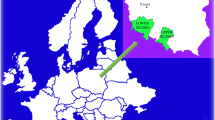Abstract
The young leaves of Clethra barbinervis Sieb. et Zucc, which is a deciduous tree species found in secondary forests widely in Japan, are used in spring as a local traditional food by local populations, and the bark of this plant is also preferred by sika deer, Cervus nippon. However, C. barbinervis has been known to accumulate heavy metals in its leaves. Then, we aimed to clarify the characteristics of microelement contents in C. barbinervis and to discuss the value of this species as food for humans and animals through the analysis of seasonal changes and distribution in various organs of C. barbinervis growing under two different geological conditions. We found that C. barbinervis is an accumulating and tolerant plant for Ni, Co and Mn. It accumulates Ni from serpentine soil containing Ni at high concentration, and Co and Mn from acidic soils based on crystalline schist. The seasonal variation in element concentrations in leaves indicates that the young leaves contain Cu at high concentration and that eating them in spring season may be advantageous to humans, due to the associated increase in Cu intake. The high concentrations of Cu and Zn in the bark of C. barbinervis might explain why deer prefer to eat the bark of this species.







Similar content being viewed by others
References
Ando, M., Yokota, H., & Shibata, E. (2003). Bark stripping preference of sika deer, Cervus nippon, in terms of bark chemical contents. Forest Ecology and Management, 177, 323–331.
Brooks, R. R. (1998). Plants that hyperaccumulate heavy metals (p. 380). Oxon: CAB International.
Baker, D. E., & Amacher, M. C. (1982). Nickel, copper, zinc and cadmium. In A. L. Page, R. H. Miller, & D. R. Keeney (Eds.), Methods of soil analysis, part 2 (2nd ed.). Madison, WI: ASA Inc. and SSSA Inc.
Grotz, N., & Guerinot, M. L. (2006). Molecular aspects of Cu, Fe and Zn homeostasis in plants. Biochimica et Biophysica Acta, 1763, 595–608.
Itoh, J., Saitoh, Y., Futatsugawa, S., Ishii, K., & Sera, K. (2007). Trace elemental analysis of wild plants by means of PIXE—Correlation of elemental concentration between soils and wild plants. Radioisotopes, 56, 291–301 (in Japanese with English abstract).
Itoh, J., Saitoh, Y., Futatsugawa, S., & Sera, K. (2006). Elemental analysis of vegetables on the market—Comparison with wild plants source. International Journal of PIXE, 16(3, 4), 209–219 (in Japanese with English abstract).
Japan Meteorological Agency (2003–2010) Meteorological data. http://www.jma.go.jp/jma/indexe.html.
Jiang, Z. W., Ueda, H., Kitahara, M., & Imaki, H. (2005). Bark stripping by sika deer on veitch fir related to stand age, bark nutrition, and season in northern Mount Fuji district, central Japan. Journal of Forest Research, 10, 359–365.
Kabata-Pendias, A. (2011). Trace elements in soils and plants (4th ed., p. 520). Boca Raton: CRC Press.
Kaji, K., Saitoh, T., Uno, H., Matsuda, H., & Yamamura, K. (2010). Adaptive management of sika deer populations in Hokkaido, Japan: Theory and practice. Population Ecology, 52, 373–387.
Kawarasaki, H. S., & Sugimura, K. (2012). Estimation of frequency and locality of collection of wild mushroom and wild vegetables by internet search. Journal of Japanese Forest Society, 94, 95–99 (in Japanese with English abstract).
Matsuura, T., Sugimura, K., Miyamoto, A., & Tanaka, N. (2014). Knowledge-based estimation of edible fern harvesting sites in mountainous communities of northeastern Japan. Sustainability, 6, 175–192.
Mizuno, T., Asahina, R., Hosono, A., Tanaka, A., Senoo, K., & Obata, H. (2008). Age-dependent manganese hyperaccumulation in Chengiopanax sciadophylloides (Araliaceae). Journal of Plant Nutrition, 31, 1811–1819.
Okamoto, K., Yamamoto, Y., & Fuwa, K. (1978). Accumulation of manganese, zinc, cobalt, nickel and cadmium by Clethra-Barbinervis. Agricultural and Biological Chemistry, 42, 663–664.
Penafiel, D., Lachat, C., Espinel, R., Van Damme, P., & Kolsteren, P. (2011). A systematic review on the contributions of edible plant and animal biodiversity to human diets. EcoHealth, 8, 381–399.
R Development Core Team. (2012). R: A language and environment for statistical computing. Vienna: R Foundation for Statistical Computing. http://www.r-project.org/
Santos, E. E., Lauria, D. C., & da Silveira, C. L. P. (2004). Assessment of daily intake of trace elements due to consumption of foodstuffs by adult inhabitants of Rio de Janeiro city. Science of the Total Environment, 327, 69–79.
Taiz, L., & Zeiger, E. (2010). Plant physiology (5th ed., p. 782). Massachusetts: Sinauer Associates Inc.
Takenaka, C., Kobayashi, M., & Kanaya, S. (2009). Accumulation of cadmium and zinc in Evodiopanax innovans. Environmental Geochemistry and Health, 31, 609–615.
Tyler, G. (2005). Changes in the concentrations of major, minor and rare-earth elements during leaf senescence and decomposition in a Fagus sylvatica forest. Forest Ecology and Management, 206, 167–177. doi:10.1016/j.foreco.2004.10.065.
Tyler, G., & Olsson, T. (2001). Plant uptake of major and minor mineral elements as influenced by soil acidity and liming. Plant and Soil, 230, 307–321.
Yang, J. E., Lee, W. Y., Ok, Y. S., & Skousen, J. (2009). Soil nutrient bioavailability and nutrient content of pine trees (Pinus thunbergii) in areas impacted by acid deposition in Korea. Environmental Monitoring and Assessment, 157, 43–50.
Acknowledgments
We would like to thank Mr. Motowo Kobayashi and the members in the Aichi Prefectural Forestry Research Institute for many helps in the sampling operation.
Author information
Authors and Affiliations
Corresponding author
Rights and permissions
About this article
Cite this article
Azuma, A.K., Tomioka, R. & Takenaka, C. Evaluation of microelement contents in Clethra barbinervis as food for human and animals in contrasting geological areas. Environ Geochem Health 38, 437–448 (2016). https://doi.org/10.1007/s10653-015-9731-y
Received:
Accepted:
Published:
Issue Date:
DOI: https://doi.org/10.1007/s10653-015-9731-y




